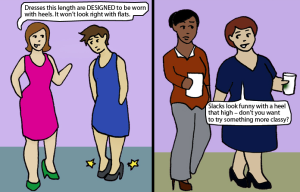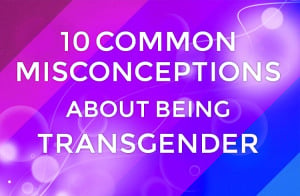Originally published on The Huffington Post and republished here with the author’s permission.
When Post-Traumatic Stress Disorder is in the news, it’s mostly because of the number of veterans suffering as a result of combat-related trauma.
Victims of other kinds of trauma can also suffer from PTSD, though, and often do without realizing it.
PTSD mirrors other mental illnesses such as depression and anxiety, and can also present as “I feel fine” when really, the “feeling fine” rooted in numbness and avoidance.
I have PTSD as a result of sexual abuse that was perpetrated on me throughout my childhood. Child sexual abuse and sexual assault are very common crimes, yet they are so stigmatized that they receive very little attention in the media from a mental health perspective.
It’s easier to report on a brave soldier coming home from war with flashbacks of violence than it is to admit that there are a lot of people out there suffering from similarly troubling symptoms that relate to their abuse or assault.
Here are some questions to ask yourself to look out for signs of PTSD in your life:
1. Has a Traumatic Event or Episode Happened to You (Or Did You Witness One)?
The threat of death, serious injury, violence, or sexual assault are all considered traumatic events.
However, not everyone experiences and perceives an event the same way, so there is no concrete list of events that can cause traumatic responses. It depends on the individual.
Witnessing these events can be traumatic, too, as can having a close friend or relative who has endured a traumatic event.
Sometimes, people don’t remember that they were exposed to a trauma. Traumatic memories are not processed and stored like regular memories.
I didn’t realize I had been a victim of sexual abuse as a child until I was an adult. In hindsight, I had a lot of PTSD symptoms even before I knew what had happened to me.
Of course, it’s not just sexual or physical abuse that can cause PTSD – growing up in an environment that doesn’t feel safe for any reason can absolutely be traumatic.
2. Are You Re-Experiencing the Traumatic Event?
The most common and well-known ways of re-experiencing a traumatic event is through flashbacks, intrusive memories, and nightmares.
There are, however, ways of re-experiencing a trauma that do not involve memories, dreams, or visions of the event.
Before I realized the extent of what had happened to me, I was re-experiencing my trauma – I just didn’t know that I was. Many of the ways I re-experienced the trauma then was through body memories. I would become overwhelmed by a particular emotion or feeling in my body.
Until recently, I wasn’t aware that I was re-experiencing my trauma, and I didn’t know that I was feeling distress or overreacting to a situation because it reminded me in some way of my trauma.
While I have flashbacks and nightmares, the primary way I re-experience my trauma is by feeling emotions and physical reactions in my body that don’t make sense when I consider what’s actually going on around me.
3. Do You Avoid Things That Remind You of the Trauma?
Trauma is scary and disruptive. It’s natural to want to avoid situations that might remind us of unpleasant or threatening events.
People with PTSD want to avoid places, activities, objects that bring up unpleasant reminders or feelings about the trauma.
People with PTSD tend to avoid thoughts or feelings that related to the trauma.
For example, I try to avoid feeling startled, because the adrenaline rush and sudden jolt reminds me of times I wasn’t safe. So, while balloons popping have nothing to do with my abuse, the feeling the loud sound brings about does.
4. Is Your Memory Out of Whack? Is Your Mood Off?
Feeling threatened and unsafe causes memories to be formed and stored differently than regular events. Sometimes people dissociate, or “check out,” while the event is going on. Inability to access memories of the event is a feature of PTSD.
Likewise, negative beliefs about the world can be indicative of PTSD. For example, it’s easy for me to believe that the world is unsafe and people should not be trusted. While there are many cynical people out there, my belief system is rooted in childhood trauma.
Blame, negative emotions (shame, fear, anger, guilt), lack of interest in activities that were enjoyable pre-trauma, isolation, and the in ability to experience positive emotions are also symptoms of PTSD.
These cognitive and emotional symptoms are among the most confusing and are the reason PTSD is often misdiagnosed.
Think about it: You feel sad, don’t like to hang out with people, think the world is a bad place, and have few activities you actually like doing. Sounds like depression, right?
5. Do Your Reactions Catch You Off Guard? Are You on High Alert?
Engaging in destructive or self-injurious behavior are common in people with PTSD.
Self-harm, for example, is a way many people cope with their past trauma. Other self-destructive behavior and addictions can be ways of dealing with the fallout as well.
Difficulty sleeping, feeling startled, always being on alert are also symptoms.
When my PTSD was at its worst, I was very jumpy and uncomfortable around people. I was always on the lookout. I didn’t know what I was looking out for, but I felt very shifty and compelled to notice everything in my environment. I also had so much trouble concentrating that I would get confused about the day of the week, or my route back home if I left the house.
Feeling startled and jumpy can also be symptoms of anxiety, so that’s a common misdiagnosis of PTSD, particularly when the person suffering from PTSD is presenting as more agitated than sad and dejected.
Does Any of This Sound Familiar?
When I figured out I had PTSD, I was surprised. I thought I was doing really well for years and years.
In hindsight, I was just numb and had a constricted range of feelings, also related to the trauma. Later, my PTSD presented with some of the more dramatic characteristics like flashbacks, nightmares, and extreme emotional reactivity.
It’s easy to explain away symptoms as more socially acceptable and common conditions. “Must be depression!” or “Oh, I guess I’ve always been hypersensitive.” Those statements are easier to say than “I think I have PTSD.”
If you’ve been the victim of a traumatic event or episode and have assumed you’re struggling with depression or anxiety, or if you feel you’re “over it,” but don’t feel much of anything when you really think about it, it might be worth familiarizing yourself with the symptoms of PTSD and get in touch with your doctor or a mental health professional who can help.
The good news is, there are many effective treatments for PTSD that can improve the way you feel and function.
If you or someone you know has been affected by sexual violence, it’s not your fault. You are not alone. For people based in the US, help is available 24/7 through the National Sexual Assault Hotline: 1-800-656-HOPE and online at rainn.org, y en español: rainn.org/es. For people outside of the US, there’s this list of resources divided by country.
[do_widget id=’text-101′]
Dani Bostick is a psychotherapist in Colorado Springs who works with individuals, couples, and families. A Maryland native and former Latin teacher, Dani now devotes most of her energy to disrupting the culture of shame and silence surrounding sexual abuse and assault. She uses the rest of her energy to take her dogs to the dog park, dominate her fantasy football league, and write about football for Behind the Steel Curtain and Crooked Scoreboard. Find her on Twitter @danibostick, Facebook, and her website.
Search our 3000+ articles!
Read our articles about:
Our online racial justice training
Used by hundreds of universities, non-profits, and businesses.
Click to learn more
Most Read Articles
- « Previous
- 1
- …
- 30
- 31
- 32




















